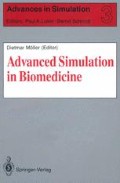Abstract
In many cases, modern large biological models snare the following properties:
-
They are “system models” i. e. “reticulations” or interconnections of elementary boxes representing structural and/or functional entities or basic mechanisms.
-
Various submodels use different formalisms: Dependent on our goals, some parts need physical modeling (electrical , mechanical or hydraulical networks, network thermodynamics); others have only black box models (compartments, chemical kinetics block diagrams.
-
They are “lumped models”: time is the only independent variable. In each box, the spatial variations of internal quantities are ignored and signal exchange between boxes is instantaneous. These models are defined by only two sets of equations:
-
(i)
“constitutive a lgebraic or ordinary differential equations” define each elementary box by relating constant parameters , variables and inputs ;
-
(ii)
“topological algebraic equations” define the constraint s imposed on the variables by the model topology (i. e. blocks interconnection).
-
(i)
-
They can be simulated with “state oriented simulation packages” which use an user supplied subroutine (called here MODEL) i. e. a procedural sequence of statements expressing the time derivatives of all state variables as functions of parameters, values of inputs and state variables.
Access this chapter
Tax calculation will be finalised at checkout
Purchases are for personal use only
Preview
Unable to display preview. Download preview PDF.
References
Breedveld, P.C.: Thermodynamic Bond Graphs. Int. J. Modelling and Simulation, 1, 57–61 (1981)
Breedveld, P.C.: A systematic method to derive Bond Graphs models, in: Proceedings of the 2nd european Simulation Conference, 241–248 Eds.: G. C. Van Steenkiste and E. J. H. Kerkhoffs, Antwerpen, SCS (1986)
Granda, J. J.: Computer generation of physical system differential equations using bond graphs. J. Franklin Institute, 319, 243–255 (1985)
Hogan, N.: Modularity and Causality in Physical system modeling. Trans. ASME, J. Dyn Syst; Meas. & Control, 109, 384–391 (1987)
Karnopp, D. C., Rosenberg, R. C.: System dynamics: A unified approach-New York: Wiley (1975)
Karnopp, D. C., Azarbaijani, S.: Pseudo Bond Graphs for generalized compartmental models in Engineering and Physiology. J. Franklin Inst., 312, 95–108 (1981)
Lefívre, J., Barreto, J.: A mixed block-diagram and Bond Graph approach to Biochemical systems with mass action and rate law kinetics. J. Franklin Inst., 319, 137–156 (1985)
Lefívre, J., Fabri, R., Roucou, D., Dríme, T., Filali, S.: An authoring system coupling simulation to computer aided instruction Proceedings IMACS-IFACS (eds. Borne, P., Tzafestas, S. L.) Lille, 511–514 (1986)
Meerman, J. W.: THTSIM, software for the simulation of continuous dynamic systems on small and very small computer systems. Int. J. Model, and Simul., 1, 52–56 (1981)
Oster, G. F., Perelson, A. S., Katchalsky, A.: Network Thermodynamic: dynamic analysis of biophysical systems. Quart. rev. Biophys., 6, 1–134, (1973)
van Dixhoorn, J. J.: Simulation of Bond graphs on minicomputers. Trans. ASME, J. Dyn. Syst; Meas. & Control, 99, 9–14 (1977)
Author information
Authors and Affiliations
Editor information
Editors and Affiliations
Rights and permissions
Copyright information
© 1990 Springer Science+Business Media New York
About this paper
Cite this paper
Lefēvre, J. (1990). An Elementary Bond Graph Approach to Structured Biological Modeling. In: Möller, D.P.F. (eds) Advanced Simulation in Biomedicine. Advances in Simulation, vol 3. Springer, New York, NY. https://doi.org/10.1007/978-1-4419-8614-6_2
Download citation
DOI: https://doi.org/10.1007/978-1-4419-8614-6_2
Publisher Name: Springer, New York, NY
Print ISBN: 978-0-387-97184-1
Online ISBN: 978-1-4419-8614-6
eBook Packages: Springer Book Archive

